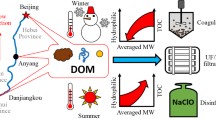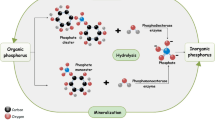Abstract
A floating bed system vegetated with Oenanthe javanica was adopted in this study to treat two types of low-pollution wastewater (LPW): polluted river water (PRW) and treated domestic wastewater (DW). The water was treated for 111 days during the low-temperature season. The results indicated that the total nitrogen (TN) removal rates were higher in the DW groups than in the PRW groups during the initial 30 days. This difference may stem from the different C/N ratio of the influent. As the water temperature rose above 15.5 °C after March 12, the purification capability of nitrogen in the DW groups was enhanced, and the removal rates of TN were 89.8 and 76.8 % in DW and the control 2 at 111 days. Conversely, the performance of total phosphorus (TP) removal was robust during the initial stage of the experiment, despite receiving domestic wastewater with a relatively high N/P ratio (16:1). The TP removal rates in DW were as high as 91.5 % compared to 78.9 % in PRW at 30 days. At the same time, the N/P ratios of plant tissue were higher in the DW groups compared to that in the PRW groups. Plant uptake played a significant role in nutrient removal in the PRW groups (52.5 % for TN, 68.2 % for TP), followed by sedimentation. In contrast, plant uptake only accounted for 25.3 % of TN removal and 24.1 % of TP removal in DW. The results provide engineering parameters for the future design of an ecological remediation technology for LPW purification.





Similar content being viewed by others
References
Ahmed, A., & Eldaw, A. (2004). Challenges and future opportunities in the Nile basin. In S. Castelein (Ed.), From conflict to co-operation in international water resources management: challenges and opportunities. Delft, the Netherlands: UNESCO-IHE Institute for Water Education.
Asaeda, T., Nam, L., Hietz, P., Tanaka, N., & Karunaratne, S. (2002). Seasonal fluctuations in live and dead biomass of Phragmites australis as described by a growth and decomposition model: implications of duration of aerobic conditions for litter mineralization and sedimentation. Aquatic Botany, 73(3), 223–239.
Brix, H. (1997). Do macrophytes play a role in constructed treatment wetlands? Water Science and Technology, 35(5), 11–17.
Bu, F., & Xu, X. (2013). Planted floating bed performance in treatment of eutrophic river water. Environmental Monitoring and Assessment, 185, 9651–9662.
Chiu, Y. C., Lee, L. L., Chang, C. N., & Chao, A. C. (2007). Control of carbon and ammonium ratio for simultaneous nitrification and denitrification in a sequencing batch bioreactor. International Biodeterioration and Biodegradation, 59(1), 1–7.
Choi, H. J., & Lee, S. M. (2015). Effect of the N/P ratio on biomass productivity and nutrient removal from municipal wastewater. Bioprocess and Biosystems Engineering, 38, 761–766.
Chung, A. K. C., Wu, Y., Tam, N. F. Y., & Wong, M. H. (2008). Nitrogen and phosphate mass balance in a sub-surface flow constructed wetland for treating municipal wastewater. Ecological Engineering, 32, 81–89.
Demars, B. O. L., & Edwards, A. C. (2008). Tissue nutrient concentrations in aquatic macrophytes: comparison across biophysical zones, surface water habitats and plant life forms. Chemistry and Ecology, 24, 413–422.
Díaz, F. J., Ogeen, A. T., & Dahlgren, R. A. (2012). Agricultural pollutant removal by constructed wetlands: implications for water management and design. Agricultural Water Management, 104, 171–183.
Estrada, V., Di Maggio, J., & Diaz, M. S. (2011). Water sustainability: a systems engineering approach to restoration of eutrophic Lakes. Computers and Chemical Engineering, 35, 1598–1613.
Geurts, J. J. M., Sarneel, J. M., Willers, B. J. C., Roelofs, J. G. M., Verhoeven, J. T. A., & Lamers, L. P. M. (2009). Interacting effects of sulphate pollution, sulphide toxicity and eutrophication on vegetation development in fens: A mesocosm experiment. Environmental Pollution, 157, 2072–2081.
Headley, T. R., & Tanner, C. C. (2012). Constructed wetlands with floating emergent macrophytes: an innovative stormwater treatment technology. Critical Reviews in Environmental Science and Technology, 42, 2261–2310.
Hermans, C., Hammond, J. P., White, P. J., & Verbruggen, N. (2006). How do plants respond to nutrient shortage by biomass allocation? Trends in Plant Science, 11(12), 610–617.
Hu, G. J., Zhou, M., Hou, H. B., Zhu, X., & Zhang, W. H. (2010a). An ecological floating-bed made from dredged lake sludge for purification of eutrophic water. Ecological Engineering, 36, 1448–1458.
Hu, M., Yuan, J., Yang, X., & He, Z. (2010b). Effects of temperature on purification of eutrophic water by floating eco-island system. Acta Ecologica Sinica, 30, 310–318.
Jiang, F., Li, Y., & Weng, B. (2002). Review on physiology of chilling stress and chilling resistance of plants. Fujian Journal of Agricultural Sciences, 17, 190–195 (in Chinese).
Kadlec, R. H., & Wallace, S. (2008). Treatment wetlands. Second (Edith ed.). Boca Raton, Florida: CRC Press.
Li, L., Zerbe, S., Han, W., Thevs, N., Li, W., He, P., et al. (2014). Nitrogen and phosphorus stoichiometry of common reed (Phragmites australis) and its relationship to nutrient availability in northern China. Aquatic Botany, 112, 84–90.
Lin, Y. F., Jing, S. R., Wang, T. W., & Lee, D. Y. (2002). Effects of macrophytes and external carbon sources on nitrate removal from groundwater in constructed wetlands. Environmental Pollution, 119, 413–420.
Lu, R. (2000). Soil agricultural chemical analysis method. Beijing, China: China Agricultural Science and Technology Press.
Matsumoto, S., Terada, A., & Tsuneda, S. (2007). Modeling of membrane-aerated biofilm: effects of C/N ratio, biofilm thickness and surface loading of oxygen on feasibility of simultaneous nitrification and denitrification. Biochemical Engineering Journal, 37, 98–107.
Myrold, D. D., & Tiedje, J. M. (1985). Establishment of denitrification capacity in soil: effects of carbon, nitrate and moisture. Soil Biology and Biochemistry, 17, 819–822.
Paranychianakis, N. V., Angelakis, A. N., Leverenz, H., & Tchobanoglous, G. (2006). Treatment of wastewater with slow rate systems: a review of treatment processes and plant functions. Critical Reviews in Environmental Science and Technology, 36, 187–259.
Ravazzini, A. M., Nieuwenhuijzen, A. F., & Graaf, J. H. M. J. (2005). Direct ultrafiltration of municipal wastewater: comparison between filtration of raw sewage and primary clarifier effluent. Desalination, 178, 51–62.
Stottmeister, U., Wießner, A., Kuschk, P., Kappelmeyer, U., Kästner, M., Bederski, O., et al. (2003). Effects of plants and microorganisms in constructed wetlands for wastewater treatment. Biotechnology Advances, 22, 93–117.
Sun, T. H., & Zhou, S. Y. (1997). Guideling of land treatment technology for municipal wastewater. Beijing, China: China Environmental Science Press.
Sun, L., Liu, Y., & Jin, H. (2009). Nitrogen removal from polluted river by enhanced floating bed grown canna. Ecological Engineering, 35, 135–140.
UN-Water/FAO. (2007). Coping with water scarcity: challenge of the 21st century. Rome, Italy: UN-Water/FAO.
Van Der Heide, T., Roijackers, R. M. M., Nes, E. H. V., & Peeters, E. T. H. M. (2006). A simple equation for describing the temperature dependent growth of free-floating macrophytes. Aquatic Botany, 84, 171–175.
Wang, G., Pu, P., Zhang, S., Hu, C., & Hu, W. (1999). The purification ability of aquatic macrophytes for eutrophic lake water in winter. China Environmental Science, 19, 106–109 (in Chinese).
Weier, K. L., Doran, J. W., Mosier, A. R., Power, J. F., & Peterson, T. A. (1994). Potential for bioremediation of high nitrate irrigation water via denitrification. Journal of Environment Quality, 23, 105–110.
Xin, Z., Li, X., Yan, Z., Zhou, Y., Jia, Y., Tang, Y., et al. (2011). Purification effects of different stubble height Oenanthe javanica (Blume) DC floating bed systems in winter in two successive experimental periods. Chinese Journal of Ecology, 30, 2745–2752 (in Chinese).
Xing, W., Wu, H. P., Hao, B. B., & Liu, G. H. (2013). Stoichiometric characteristics and responses of submerged macrophytes to eutrophication in lakes along the middle and lower reaches of the Yangtze River. Ecological Engineering, 54, 16–21.
Xu, L. Y., Ma, H. H., Wang, C. W., Wang, X. F., & Wang, S. L. (2013). Removal of nitrogen and phosphorus by two plants cultivated on floating bed at different N/P ratios. Journal of Yangtze River Scientific Research Institute, 30, 8–11 (in Chinese).
Xue, Y., Kovacic, D. A., David, M. B., Gentry, L. E., Mulvaney, R. L., & Lindau, C. W. (1999). In situ measurements of denitrification in constructed wetlands. Journal of Environment Quality, 28(1), 263–269.
Zhang, Z., Feng, M., & Yang, L. (2007). Nitrogen and phosphorus removal and N2O emission from domestic sewage in floating-bed plant systems. Acta Ecologica Sinica, 27, 4333–4341 (in Chinese).
Zhang, Q., Achal, V., Xu, Y., & Xiang, W. N. (2014). Aquaculture wastewater quality improvement by water spinach (Ipomoea aquatica Forsskal) floating bed and ecological benefit assessment in ecological agriculture district. Aquacultural Engineering, 60, 48–55.
Zhao, L. F., Zhu, W., & Zhao, J. (2006). Nitrogen removal mechanism in constructed wetland used for treating polluted river water with lower ratio of carbon to nitrogen. Acta Scientiae Circum Stantiae, 26, 1821–1827 (in Chinese).
Zhao, Y. J., Liu, B., Zhang, W. G., Ouyang, Y., & An, S. Q. (2010). Performance of pilot-scale vertical-flow constructed wetlands in responding to variation in influent C/N ratios of simulated urban sewage. Bioresource Technology, 101, 1693–1700.
Zhao, Y. J., Hui, Z., Chao, X., Nie, E., Li, H. J., He, J., et al. (2011). Efficiency of two-stage combinations of subsurface vertical down-flow and up-flow constructed wetland systems for treating variation in influent C/N ratios of domestic wastewater. Ecological Engineering, 37, 1546–1554.
Zhou, S., & Hosomi, M. (2008). Nitrogen transformations and balance in a constructed wetland for nutrient-polluted river water treatment using forage rice in Japan. Ecological Engineering, 32, 147–155.
Zhou, X., & Wang, G. (2010). Nutrient concentration variations during Oenanthe javanica growth and decay in the ecological floating bed system. Journal of Environmental Sciences, 22, 1710–1717.
Zhou, X., Wang, J., Xue, L., Xu, X., & Yang, L. (2005). N and P removal characters of eutrophic water body under planted float. Chinese Journal of Applied Ecology, 16, 2199–2203 (in Chinese).
Zhu, L., Li, Z., & Ketola, T. (2011). Biomass accumulations and nutrient uptake of plants cultivated on artificial floating beds in china’s rural area. Ecological Engineering, 37, 1460–1466.
Acknowledgements
This work was financially supported by the Jiangsu Agriculture Science and Technology Innovation Fund (No. CX(14)2050), the Major Science and Technology Project of Water Pollution Control and Management in China (No. 2012ZX07101-004), the Open Foundation of State Key Laboratory of Soil and Sustainable Agriculture (No. Y412201428), and the National Natural Science Funds of China (Grant No. 41501324).
Author information
Authors and Affiliations
Corresponding author
Rights and permissions
About this article
Cite this article
Duan, J., Feng, Y., Yu, Y. et al. Differences in the treatment efficiency of a cold-resistant floating bed plant receiving two types of low-pollution wastewater. Environ Monit Assess 188, 283 (2016). https://doi.org/10.1007/s10661-016-5286-3
Received:
Accepted:
Published:
DOI: https://doi.org/10.1007/s10661-016-5286-3




